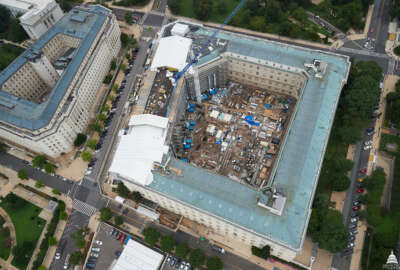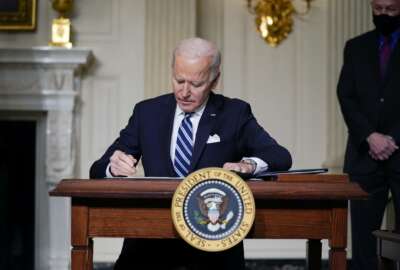Cannon House Office building renovations approaching $1B
For the latest assessment of the project, Federal Drive with Tom Temin turned to the managing director of infrastructure operations at the Government...
Best listening experience is on Chrome, Firefox or Safari. Subscribe to Federal Drive’s daily audio interviews on Apple Podcasts or PodcastOne.
It took three years to build and now the Cannon House Office Building, once known as the Old House Office Building, is in the midst of a redo that will take 10 years. The original cost is unknown, but the renovation is heading towards $1 billion. For the latest assessment of the project, Federal Drive with Tom Temin turned to the Managing Director of Infrastructure Operations at the Government Accountability Office, Terry Dorn.
Interview transcript:
Terry Dorn: The project is broken down into five phases so that they can accommodate Congress in their two year cycle. And so each phase is broken into two years, and they intend to finish a phase before the next class of congressman comes in.
Tom Temin: So the building is occupied while this is going on?
Terry Dorn: Yes, which is certainly a complication for any sort of construction project.
Tom Temin: Because if you could clear the mountain, it probably could have been done in five years. Safe to say?
Terry Dorn: Yes, yes it could be done a lot faster if the building was unoccupied.
Tom Temin: Alright. So what is the first three phases that they have finished with what is the status of the building at this point?
Terry Dorn: So the first three phases, the first one was just all the basic utilities, the behind the wall, the under the floor, things that no one gets too excited about unless you’re an engineer like me. And then the next two phases, were two of the walls. If you think of the last four phases, each one is a different wall of this large block wide building. So the first two phases are done, we’re in the middle of the third phase. So we are about halfway through this project.
Tom Temin: In other words, it’s a four sided hollow building, and they’re doing a side of the time.
Terry Dorn: That’s correct.
Tom Temin: Almost like the Pentagon was done a wedge at a time.
Terry Dorn: It would be very similar to that wedge at the time. Yes, exactly. And that includes up at the fifth floor where there was storage, or converting storage into additional offices, because as you can imagine, as you know, since 1900, the Congress has grown and there is certainly a crunch for office space in the Capitol building.
Tom Temin: And that fifth floor was originally built after the completion of the original building. They added the fifth floor some years later, to make more offices, but it sounds like that office space got taken away for storage of junk, and now they need it for people.
Terry Dorn: Right. And that’s been one of the complications too, is taking the roof off and building a new roof, essentially adding another floor to not get bad buildings, they had to build a roof enclosure to enclose each one of these wedges while they were doing it.
Tom Temin: It sounds like they might have been lucky because they didn’t discover anything horrifying that had to be done that would drive the cost and schedule up, such as a rotten foundation or the building was sinking or that kind of thing. Is it safe to say it’s basically sound?
Terry Dorn: Exactly. The building’s basically sound and needed modern housing brought up the current codes, such as the ADA. They found a few minor things that you would expect in an old building, a little bit of asbestos here and there, that sort of thing. But nothing that wasn’t handled properly. And the building is going to be a great building for another 100 years when it’s done.
Tom Temin: Well. So it wasn’t like a Florida condo tower or something.
Terry Dorn: But it could have been if you left it alone. Back in 2004 or so when they started designing this building stuff was falling off the outside of the building. 2004 is when they were beginning to do condition assessments of this building. And it took them about 10 years to get from there to, hey do have enough money to renovate.
Tom Temin: Golly, the FBI must be looking at this thing with a lot of jealousy. We’re speaking with Terry Dorn, the managing director of infrastructure issues at the Government Accountability Office. And the cannon, is it considered historically significant or architecturally significant?
Terry Dorn: Yes, it is, again, the oldest congressional office building on the Hill, and it’s just a beautiful building. I encourage everyone after COVID to go check it out.
Tom Temin: Yeah, those buildings, they did use nice materials. And they used world class architects at the time. Who manages a project for the Capitol? It’s not the GSA though is it?
Terry Dorn: No, it’s the Architect of the Capitol. They’re responsible for all of the buildings on Capitol Hill.
Tom Temin: And do you have any recommendations for them?
Terry Dorn: My recommendations for them are continued to do these risk assessments and keep communication open with Congress, whether or not you’re renovating a billion dollar building, or you’re renovating the kitchen for your spouse, manage your risks, keep communication open, and try to stay within your budget.
Tom Temin: Yeah, sure. And speaking of kitchens, I mean, there are kitchens in this building. But I was surprised to understand that when it was originally opened, every single congressional office had running water in that office. You didn’t have to go down the hall. So Is that still the case as far as you know, for when it reopens?
Terry Dorn: Yes, the members will have separate restrooms and things to take care of their privacy and security. So yes, there is running water still running in the proper places.
Tom Temin: Like in New York, water has to be over water so they can’t move the bathrooms, meet with the codes. And what about the computer communications, the digital infrastructure of the building, has that been something they’ve upgraded also while they’ve been doing this?
Terry Dorn: Absolutely. Upgrading all of the systems: the cabling, the internet systems, the fire alarm systems, the building control systems – all of that sort of infrastructure has been one of the main reasons to do this project.
Tom Temin: Even though this project is on schedule, the budget that was originally offered is being pretty much busted, isn’t it? What what are the cost trends here?
Terry Dorn: So the cost is projected to go up, the architect of the capital is conducting another risk assessment of the cost and the schedule, and that is due to be completed in November. But they’ve identified several risks, as you would expect, COVID has reared its ugly head on this project. There could be delays just for access to the building, would cause supply chain issues, it’s harder to get things, the price of lumber, as you heard, went up a lot during COVID. And then the Capitol attack also caused additional security concerns, inside access issues, which made it harder to get into the building to work.
Tom Temin: So the estimates gone up by a couple of hundred million dollars since the original.
Terry Dorn: The original estimate was in the $753 million range. And the last official estimate, I believe, was about $890 million. And the Appropriations Committee, I believe, just appropriated another $93 million to the project and cited that there is about $20 million that they were expecting over cost risk.
Copyright © 2025 Federal News Network. All rights reserved. This website is not intended for users located within the European Economic Area.
Tom Temin is host of the Federal Drive and has been providing insight on federal technology and management issues for more than 30 years.
Follow @tteminWFED






